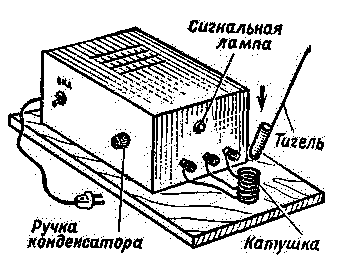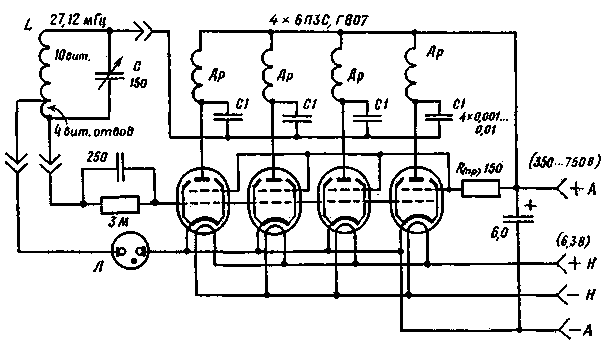Small-sized high-frequency installation for melting metals. Encyclopedia of radio electronics and electrical engineering

Encyclopedia of radio electronics and electrical engineering / welding equipment
 Comments on the article
Comments on the article
If there is a need to melt metal (brass, aluminum, zinc, silver, etc.) in small volumes, you can use an RF installation for melting metals with induction currents. The general fork of the installation is shown in Fig. 1, and the circuit diagram is shown in Fig. 2.

Fig.1. General view of a high-frequency installation for melting metals
The RF generator generates oscillations with a frequency of 27,12 MHz; it is assembled on four electron tubes (tetrodes). The neon lamp indicates that the unit is ready for operation. The handle of the variable capacitor (CPE) C is brought out. At the highest capacity of the KPI, a piece of metal placed and tkgl is rapidly heated, which is introduced into the coil L. To melt a piece of zinc
it is enough to heat it for 15-20 s. Coil L - frameless, consists of 10 turns of PEV 0,8 wire, the inner diameter of the coil is 12 mm. If it is necessary to increase the diameter of the coil L without changing the oscillation frequency of the generator, you can use the calculation, i.e., recalculate the coil associated with a change in its diameter.

Schematic diagram of the installation
Capacitor C of variable capacity can be taken from the radio (with every second plate removed). The power of the installation is such that it almost instantly heats a screwdriver to red heat. The rate of metal melting in such installations depends primarily on the generator power, frequency, hysteresis losses and eddy current losses in a piece of metal. Lamps must be powerful, but their number when connected in parallel should not exceed four.
Capacitors C1 are ceramic or mica with an operating voltage of 1500-2000 V, if triodes are used, the resistor R is not needed. The HF unit is powered from the 127 or 220 V AC mains through a rectifier, which can be mounted together with the unit or placed in a separate unit. When working with the installation, it is necessary to strictly observe the safety regulations.
Note. Dr throttle data in installation. Coreless coil 10 turns, distance between turns 1 mm, PEV wire 0,6, coil diameter 9 mm. The crucible is ceramic. As a power source, you can use any power transformer from tube TVs or a tube radio that had at least 5-6 radio tubes. Or, using practical advice 25, calculate and manufacture a power transformer with a power of 250-300 watts.
Literature:
- V.G.Bastanov. 300 practical tips. Moscow worker, 1986.
Publication: N. Bolshakov, rf.atnn.ru
 See other articles Section welding equipment.
See other articles Section welding equipment.
 Read and write useful comments on this article.
Read and write useful comments on this article.
<< Back
 Latest news of science and technology, new electronics:
Latest news of science and technology, new electronics:
Air trap for insects
01.05.2024
Agriculture is one of the key sectors of the economy, and pest control is an integral part of this process. A team of scientists from the Indian Council of Agricultural Research-Central Potato Research Institute (ICAR-CPRI), Shimla, has come up with an innovative solution to this problem - a wind-powered insect air trap. This device addresses the shortcomings of traditional pest control methods by providing real-time insect population data. The trap is powered entirely by wind energy, making it an environmentally friendly solution that requires no power. Its unique design allows monitoring of both harmful and beneficial insects, providing a complete overview of the population in any agricultural area. “By assessing target pests at the right time, we can take necessary measures to control both pests and diseases,” says Kapil ... >>
The threat of space debris to the Earth's magnetic field
01.05.2024
More and more often we hear about an increase in the amount of space debris surrounding our planet. However, it is not only active satellites and spacecraft that contribute to this problem, but also debris from old missions. The growing number of satellites launched by companies like SpaceX creates not only opportunities for the development of the Internet, but also serious threats to space security. Experts are now turning their attention to the potential implications for the Earth's magnetic field. Dr. Jonathan McDowell of the Harvard-Smithsonian Center for Astrophysics emphasizes that companies are rapidly deploying satellite constellations, and the number of satellites could grow to 100 in the next decade. The rapid development of these cosmic armadas of satellites can lead to contamination of the Earth's plasma environment with dangerous debris and a threat to the stability of the magnetosphere. Metal debris from used rockets can disrupt the ionosphere and magnetosphere. Both of these systems play a key role in protecting the atmosphere and maintaining ... >>
Solidification of bulk substances
30.04.2024
There are quite a few mysteries in the world of science, and one of them is the strange behavior of bulk materials. They may behave like a solid but suddenly turn into a flowing liquid. This phenomenon has attracted the attention of many researchers, and we may finally be getting closer to solving this mystery. Imagine sand in an hourglass. It usually flows freely, but in some cases its particles begin to get stuck, turning from a liquid to a solid. This transition has important implications for many areas, from drug production to construction. Researchers from the USA have attempted to describe this phenomenon and come closer to understanding it. In the study, the scientists conducted simulations in the laboratory using data from bags of polystyrene beads. They found that the vibrations within these sets had specific frequencies, meaning that only certain types of vibrations could travel through the material. Received ... >>
 Random news from the Archive Random news from the Archive The rich live 9 years longer than the poor
22.12.2018
Scientists at the Catholic University of Louvain (Belgium) studied the issue of "equality or inequality of the Belgians in relation to death."
According to the study, the disparity in the health status of the wealthy classes and the poor eloquently confirms the well-known truth that "it is better to be rich and healthy": the life expectancy of the poor is 6,6 years shorter for women and 9,1 years for men .
Comparing the personal data of all Belgians entered in the national population register from 1991 to 2016, examining the results of the 1991, 2001 and 2011 censuses and the archive of death certificates, the researchers stated "staggering differences between social groups", the newspaper writes.
In other words, people who are in a better socio-economic position, who have received a higher level of education and who have better housing, live much longer, often by a decade, than those who are at the other end of the social scale.
|
 Other interesting news:
Other interesting news:
▪ Headphones Philips Fidelio L2
▪ New MOSFETs for automotive applications from Toshiba
▪ Potatoes with "awakened" genes successfully resist late blight
▪ External panoramic camera for smartphones Huawei EnVizion 360
▪ Catch the neutrino
 News feed of science and technology, new electronics
News feed of science and technology, new electronics
 Interesting materials of the Free Technical Library:
Interesting materials of the Free Technical Library:
▪ site section Chargers, accumulators, batteries. Article selection
▪ article Move away from evil and do good. Popular expression
▪ article Which animal has annual rings like trees? Detailed answer
▪ article Occupational safety during road works
▪ article Cement for gluing glass plates. Simple recipes and tips
▪ Article Pocket Sundial. physical experiment
 Leave your comment on this article:
Leave your comment on this article:
Comments on the article:
Jury
Is it possible to do this with two G811 lamps. Will the scheme change?
Alexander
Does not work!!!
Leonid
Can you be more specific about the variable capacitor, what voltage does it have and how many turns are needed and what diameter for the chokes?
Sergei
This design is described in Wojciechowski's collection "Radio-Electronic Toys".
Leonid
but you can do it on lamps 6p36s
Alexander
I spent a lot of time, the drill worked for 6, it warmed up instantly, although the first lamp quickly turned green and then the second one at that time broke through the first one. Further work with it did not give a positive result [down] [down]
 All languages of this page
All languages of this page
Home page | Library | Articles | Website map | Site Reviews

www.diagram.com.ua
2000-2024







 Arabic
Arabic Bengali
Bengali Chinese
Chinese English
English French
French German
German Hebrew
Hebrew Hindi
Hindi Italian
Italian Japanese
Japanese Korean
Korean Malay
Malay Polish
Polish Portuguese
Portuguese Spanish
Spanish Turkish
Turkish Ukrainian
Ukrainian Vietnamese
Vietnamese


 Leave your comment on this article:
Leave your comment on this article: